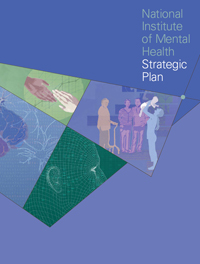Archived Content
The National Institute of Mental Health archives materials that are over 4 years old and no longer being updated. The content on this page is provided for historical reference purposes only and may not reflect current knowledge or information.
New NIMH Strategic Plan Accelerates Mental Health Research
• Science Update

Building on the recent rapid advances in understanding the science of brain and behavior, the new National Institute of Mental Health (NIMH) strategic plan is designed to maintain momentum in research and transform the diagnosis, treatment, and prevention of mental disorders.
“To fulfill the Institute’s public health mission, we need to make sure that breakthroughs in science become breakthroughs for people with mental disorders,” said NIMH Director Thomas R. Insel, M.D. “This strategic plan represents NIMH’s commitment to continue the accelerated pace of scientific progress by generating the best mental health research that will have the greatest public health impact and continue to fuel the transformation of mental health care.”
Mental disorders are the leading cause of disability in North America,1 with roughly 1 in 17 adults suffering from a seriously debilitating mental illness in the United States alone.2,3 To address this burden, NIMH has identified four strategic objectives to guide its research efforts over the next five years:
- Promote discovery in brain and behavioral sciences to fuel research on the causes of mental disorders
- Chart mental illness trajectories to determine when, where, and how to intervene
- Develop new and better interventions that incorporate the diverse needs and circumstances of people with mental illnesses
- Strengthen the public health impact of NIMH-support research.
These objectives include redefining mental disorders into observable and measurable components that are more closely aligned with the biology of the brain; fostering broad sharing of data and resources among the scientific community; and training and supporting new researchers in ways that inspire creativity and innovation.
NIMH will devote significant resources to initiatives and funding opportunities that emerge from the themes and objectives in the plan. In addition, the Institute will use the strategic plan to prioritize funding for applications that are not related to a specific initiative.
The document represents the culmination of a year-long initiative launched by NIMH to develop a new strategic plan that will serve as a guide to NIMH for advancing mental health science over the next five years. Its development has been a collaborative effort among scientific experts, advocacy groups, NIMH staff and more than 500 members of public who provided input.
The NIMH strategic plan is available in print and can also be read online.
1 The World Health Organization. The World Health Report 2004: Changing History, Annex Table 3: Burden of disease in DALYs by cause, sex, and mortality stratum in WHO regions, estimates for 2002. Geneva, Switzerland: The World Health Organization, 2004.
2 Kessler RC, Chiu WT, Demler O, Merikangas KR, Walters EE. Prevalence, severity, and comorbidity of twelve-month DSM-IV disorders in the National Comorbidity Survey Replication (NCS-R). Archives of General Psychiatry, 2005 Jun;62(6):617-27. PMID: 15939839
3 U.S. Census Bureau Population Estimates by Demographic Characteristics. Table 2: Annual Estimates of the Population by Selected Age Groups and Sex for the United States: April 1, 2000 to July 1, 2004 (NC-EST2004-02) Source: Population Division, U.S. Census Bureau Release Date: June 9, 2005.
